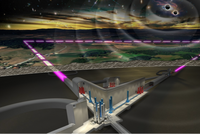The Einstein Telescope, a 3G Gravitational Wave Observatory
Although the current second generation of gravitational wave detectors is providing important discoveries and many detected events, these detectors are limited in their sensitivity.
The main cause of the limitation of these gravitational wave detectors is the underlying noise, which in turn limits their luminosity-distance sensitivity.
In addition, current detectors are only sensitive to a limited range of gravitational wave frequencies, and many events might be missed due to this limitation.
The Einstein Telescope, also known as ET, is a proposed underground third-generation gravitational wave observatory that will be built in Europe (two candidate sites: one in Sardinia and one in the Euregio Meuse-Rhine) and will operate after 2035.
This new detector, for which multiple configurations are now being studied within the ET Collaboration, will allow us to extend the current searches not only in terms of masses and detected events but it will allow us to search and observe gravitational waves from events with high redshift.
Access to a redshift of up to 100 means that a study of the population of events through cosmic ages will be possible. I participate in the ET collaboration and ongoing studies related to populations and the preparation of analyses.
